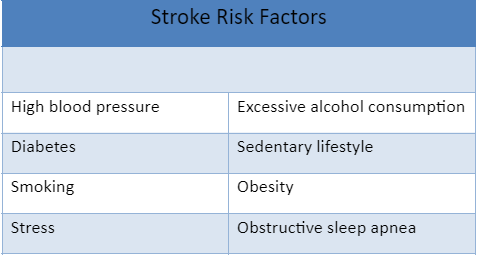
A stroke is a critical medical condition that demands immediate attention and proper awareness. This article aims to educate you with a comprehensive understanding of stroke by exploring the risk factors, common symptoms, and preventive measures.
Synopsis
What is a Stroke?
A stroke is an acute neurological condition. It occurs because of a disturbance of blood supply to a part of the central nervous system (most commonly, the brain; less frequently, the eye or the spinal cord). There are two main types of stroke. The more common one involves a blocked blood vessel - called Ischemic Stroke. This catastrophic condition can result in significant disability or even death, making it the leading cause of disability among hospitalised patients. The other type of stroke is called Hemorrhagic stroke, which results from bleeding in the brain.
Identifying stroke symptoms early and seeking help from a top neurologist in Bangalore is paramount to potentially reversing stroke.
Warning Signs and Symptoms of a Stroke
In stroke, the symptoms can be termed with the acronym - F.A.S.T.:
- F = Facial weakness
- A = Arm weakness
- S = Speech difficulty
- T = Time
In 90% of cases, any of the above indicates a person having a stroke.
In simpler terms, common ischemic stroke symptoms include weakness on one side of the body, particularly the arm or leg, and sudden loss of speech. In such cases, there's no time to waste. You must rush the patient to the nearest hospital for a CT or MRI scan to determine the appropriate treatment.
What Are the Risk Factors Involving Strokes?
The risk factors for a stroke closely resemble those of heart attacks. Below, we have mentioned the most common concerns:

Stroke at a young age (between 30-40 years) is largely attributed to all of these modifiable lifestyle factors.
Another very crucial factor to consider is stress. It is one of the prevalent reasons for young individuals having stroke. Job pressure leads to reduced relaxation hours and sleep. This, in turn, contributes to a more stressed-out situation. This situation also directly impacts one’s blood pressure, blood sugar levels, and cholesterol. Obstructive sleep apnea, often under-recognised, can also contribute to stroke risk by lowering blood oxygen levels during sleep.
Stroke: How to Diagnose?
Diagnosing a stroke promptly is crucial for effective intervention and recovery. Our expert neurology consultants in Manipal Hospital Millers Road order various diagnostic procedures to assess and confirm the presence of a stroke.
- Imaging tests, like an MRI or CT scan, provide detailed images of the brain. It can identify the areas affected by reduced blood flow or bleeding.
- A carotid ultrasound can evaluate blood flow in the neck arteries.
- Blood tests may be employed to assess glucose levels and clotting factors.
- An electroencephalogram (EEG) can help monitor electrical activity in the brain.
These diagnostic procedures also help determine the type of stroke (ischemic or hemorrhagic), or read the signs of a stroke before it happens and guide doctors in planning an appropriate treatment method.
Management of a Stroke
Early detection of a stroke is crucial for better patient outcomes. The “Golden Hour” in stroke care refers to the critical time frame during which administering treatment yields the best results.
Recent advancements have revolutionised stroke treatment with two key modalities for blocked blood vessels causing strokes.
- Intravenous Thrombolysis
It involves the administration of a drug, dissolving blood clots, and restoring its flow to the brain. This treatment should be initiated within 3 to 4.5 hours of symptom onset. Ideally, the earlier the drug is administered, the better the outcome will be! This emphasises the need for rapid identification of stroke symptoms and prompt hospitalisation.
- Mechanical Thrombectomy
This procedure is similar to angioplasty in heart care. Here, a wire is guided through blood vessels from the legs to the brain to remove clots. Long-term stroke management is equally important which largely focuses on controlling blood pressure and diabetes. It also includes lifestyle modifications such as quitting smoking, reducing alcohol consumption, and staying physically active. Indeed, prevention through risk factor control can be more effective than seeking a cure.
Manipal SOS QR Code - Rapid Response
Long travel distances to reach a hospital during a stroke are not feasible. This is especially true in traffic-prone areas like Bangalore. Manipal Hospitals has recently introduced an SOS QR Code which has been playing a crucial role in the prevention of strokes for many. It enables rapid ambulance dispatch by pinpointing the patient's location and directing them to the nearest stroke-ready hospital. The ambulance also alerts the emergency department of the hospital. This allows them to be ready and reduces the time of treatment initiation - called "door to needle".
Minimising the delay between symptom onset and treatment initiation is essential in stroke care. For the most effective treatment plan, you can consult the best neurologist in Bangalore.
FAQ's
If one feels numbness in the face, leg, or arm suddenly, especially on the body’s one side, it can be a warning. One may also experience sudden confusion, trouble speaking, difficulty understanding speech, severe headaches, and trouble walking.
A Transient Ischemic Attack (TIA) is temporary and often referred to as a "mini-stroke". It usually resolves on its own within 24 hours, leaving no lasting damage. However, they indicate an increased risk of a more severe stroke and should prompt immediate medical attention.
Yes, many strokes are preventable through lifestyle modifications and risk factor management. A healthy diet, regular exercise, controlling diabetes and blood pressure, and avoiding tobacco and excessive alcohol intake are major preventive measures for a stroke.



















 4 Min Read
4 Min Read

















